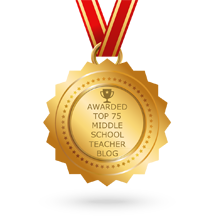Hi all and welcome back for the On Your Mark book study! Apologies for being so late with it today, but it's a super hectic time with end-of-the-year activities going on, but I know you all know what I'm talking about!
Today we are discussing chapters 3-6 - whichever pertain to your grade level and/or interests. These chapters include discussions on:
Chapter 3: Challenge Plus and Minus and Half-Grade Increments
Chapter 4: Challenge Bell-Shaped Grade Distributions
Chapter 5: Challenge the Computation of Class Rank
Chapter 6: Challenge the Use of a Single Grade
Ideas in chapters 3 and 6, in particular stood out to me. So, I'd like to share a few insights from those chapters with you!
Illusion of Precision (p. 37)
In chapter 3, Guskey discusses the fact that the more categories for grades their are, the harder it is to evaluate what the student can actually do. Take the 100 point grading scale: when it's combined with the 0, there are then 101 categories with which to rate. With the A B C D F scale, including plusses and minuses, there are 12. Guskey writes,
"What do you suppose would happen in the number of distinct levels of performance in that grading scale was increased to include twelve categories? Do you think consistent ratings would be easier to attain? Actually, quite the opposite would occur. Significant psychometric research shows that the largest number of categories that can be use to yield acceptably consisten or reliable scoring is five to seven at most. Even with extensive training, acceptable consistency among human graders simply cannot be achieved with a grading scale that includes as many as twelve categories."So while it seems like a B+ would reveal that the child is "more B" than a B-, it doesn't really tell us what the child can or can't do. On the other hand, when teachers write rubrics to describe student learning, student abilities become very clear.
Now that we've started using Standards Based Grading (SBG), we use a four point scale. Sometimes it's even hard to get four indicators that could describe student progress on one particular standard. Take this first grade standard, for example:
Could you imagine writing 12 or more categories to describe learning? But I guess I'm getting away from the point, because the traditional 100 point and the ABCDF scales don't name specific learning - they are just an average of points. When a student walks out of a writing class with the traditional grading methods, what does that A or B or 77% really mean? With rubrics like the one above, we can really convey what students can and can't do, and provide a pathway to exemplary work!
Hodgepodge Grading (p. 73)
Anyone who has kept grades in a traditional manner is guilty of this. You have grades for homework (completion and/or for accuracy). Then there's grades for participation, for effort, for tests, quizzes, projects. All these are reduced to numbers, averaged together, and a final grade is reported. But, what does that final grade really tell us? A student who earned an A or a B from me, what does that mean? Really good? Good?
Instead of the traditional grading, SBG supports the idea of multiple grades within one content area. Grades would be reported for Product, Process, and in some cases, Progress.
Product
This includes academic achievement and performance on learning tasks. This grade reports what the students know and are able to do, for example, grades on assessments and projects.
Process
This reflects how students students get to the final learning; their effort, homework, participation, responsibility, and/or work habits.
Progress
How much learning the student gained; usually used with an Individualized Education Plan, and it reports on how much learning students gained in the unit.
So the students who do no homework, but always master content and get to the learning, they would earn a high score for Product, but a low score for Process. On the other hand, students who do every assignment on time, but still struggle to master learning concepts would earn high marks for Process, but lower marks for Product. You can see how this kind of grade reporting would provide students and teachers with more information that really reflects what students can and can't do.
What are your thoughts about SBG? The more I think about it, the more I realize it is something that makes sense in my mind! Although I'm not a classroom teacher anymore, this would be the way I would want to report to families and students how they are doing in my class.
Please share your ideas about these chapters! Write a blog and link it up with me below!
The final book study post will be next Thursday, May 28th. I so promise to be on time! :-)























0 comments:
Post a Comment